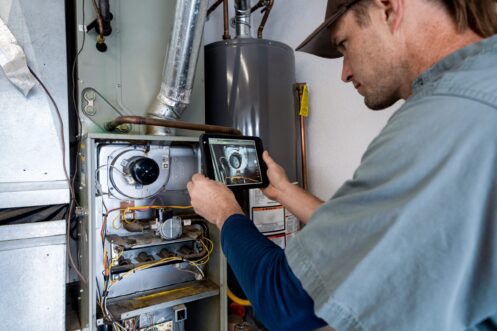
Regular tune-ups of your home’s heating system can prolong its lifespan and usefulness. Discover the common furnace problems you can prevent with routine furnace maintenance.
Dirty Filters
Dirty filters restrict airflow in your furnace, forcing it to work harder to heat your home. This exertion causes the furnace to use more electricity or gas, raising your monthly heating bills. It also increases the carbon footprint your home has on the environment.
Ignition Problems
A yearly tune-up can prevent ignition and pilot light problems. Delayed or failed ignition raises several risks, including gas buildup in the combustion chamber. This buildup increases the chances of small explosions that strain your furnace and also elevates the risk of a carbon monoxide leak.
Blower Motor Failure
You can also prevent blower motor failure with regular furnace tune-ups. When the blower motor fails, your furnace might blow out cold air. You may also feel weaker airflow coming from the vents and hear your furnace making unusual noises.
Thermostat Malfunction
When you turn on your heater, you expect it to provide you with reliable air temperature readings. You can keep the thermostat in your heater working normally by having an HVAC technician inspect and test it at least once a year.
Frequent Cycling
Continuous cycling also causes your furnace to use more energy and raises your monthly heating bills. You can help the heating system work more efficiently and avoid cycling constantly or turning itself on and off too frequently by having it professionally maintained regularly.
Unusual Noises
Routine upkeep of the heater can stop it from making unusual noises. When parts like screws fall off or motor parts need lubricating, they can cause your furnace to make banging, squealing or rattling noises. An HVAC technician can repair, lubricate or replace these components.
Heat Exchanger Cracks
If you have a gas furnace in your home, you must remain vigilant about preventing carbon monoxide leaks. Part of this vigilance involves maintaining the heat exchanger in the furnace. Routine maintenance minimizes or prevents the heat exchanger from developing cracks that can increase the risk of CO leaks.
Dirty Burners
You can also boost your home’s air quality even while the furnace runs by keeping the furnace burners clean. Regular tune-ups typically involve cleaning off dirty burners.
Worn-out Belts
Continued use of your furnace can cause the belts in its motor to wear out. Noises like squealing and screeching can indicate the belts have worn out or broken and need replacing. You can have the belts professionally inspected and replaced as needed with a thorough annual heating system tune-up.
Blocked Vents
An HVAC technician can also inspect and clean out the furnace’s vents. Blocked vents restrict airflow, compromise your heater’s efficiency and contribute to higher heating bills. A technician has the resources to inspect the vents, reach and remove clogs and ensure your furnace blows out warm air.
Faulty Limit Switch
A faulty limit switch can cause your furnace to overheat, putting its usefulness, safety and lifespan at risk. Regular upkeep can involve testing the limit switch to ensure it works normally and minimizes the chances of your furnace overheating.
Electrical Problems
Electrical problems like tripped breakers, frayed wiring and weak connections can impact how well you can keep your home warm. Routine heating tune-ups can protect the electrical components in your heater, allowing them to work normally and helping you keep your home at a comfortable temperature.
Gas Line Issues
A blockage in the gas line or dirt buildup on the flue can increase the risk of a gas leak and poor heating. The pilot light in your heater might burn yellow or orange instead of blue when it does not receive enough gas or the furnace develops a gas leak in one of its lines.
Dirty Flame Sensor
A dirty flame sensor can cause the furnace to shut down unexpectedly. To keep it running normally and avoid disruptions with its normal operation, you can have an HVAC technician clean the flame sensor.
Clogged Drain Lines
Yearly tune-ups help prevent drain line clogs in the heating system. Clogged drain lines lead to problems like water leaks. They also compromise your heater’s efficiency. Over time, these lines can accumulate residue like slime and algae that create clogs and restrict the drain lines’ outlets.
Faulty Thermocouple
The thermocouple in a furnace monitors the pilot light. It consists of a metal rod that detects a flame from the pilot light and keeps the gas valve open. You can avoid the thermocouple working normally with regular maintenance.
Leaky Ductwork
Leaky ductwork makes it more difficult for your heater to keep your house warm. They also reduce your furnace’s efficiency and raise your energy costs. Having an HVAC technician inspect the ductwork and seal any openings in and around them prevents these issues.
Overheating
Factors like short cycling, blocked airflow, a blocked inlet and a bad motor blower can all contribute to your furnace overheating. Overheating can shorten the heater’s safe use and lifespan. Preventing these issues starts with a yearly inspection and tune-up of your heating system.
Poor Airflow
A broken blower, along with clogged or damaged vents and dirty air filters, can lead to poor airflow from your heating system. During a tune-up, your technician can test air coming from the vents and then find out and resolve the cause of poor airflow.
Pilot Light Issues
The pilot light serves as the ignition source for the main burner in your heating system. When the thermostat tells the system it needs more heat, the pilot light lights the gas burner. Routine servicing of the heating system prevents issues with your pilot light.
Faulty Blower Capacitor
The capacitor regulates power for the blower motor when the heater starts up and for as long as you have the heater running. You must have this part inspected and maintained to mitigate the chances of it breaking down and creating problems with the blower motor.
Faulty Gas Valve
The furnace’s gas valve regulates the flow of gas from your propane tank or the supply line by opening or closing as needed to allow or restrict gas to the burners and pilot light. Maintaining it prevents this valve from malfunctioning and compromising your furnace’s ability to heat your house.
Clogged Air Intake
Keeping the air intake clear improves airflow in your home’s heating system. This measure also helps improve your heater’s energy efficiency, which can keep your heating bills more affordable.
Worn-out Bearings
Worn-out bearings can contribute to problems with your heater’s blower motor and reduce the system’s efficiency. A yearly inspection and tune-up can reveal if the bearings in the blower motor have worn out and need lubricating or replacing.
Dirty Heat Exchanger
You can mitigate the risk of carbon monoxide leaks in your home by keeping the heat exchanger clean. A clean heat exchanger also helps the furnace function more efficiently.
At Rosenberg Plumbing & Air, we have 37 years of experience providing customers in the San Antonio service area with reliable furnace maintenance. Our team also offers follow-up services to ensure our customers are happy with our services, as well as furnace repairs. We also work on air conditioners and plumbing systems, as well as offer indoor air quality services. Contact us today to schedule furnace maintenance for your home.
Tags: Heating Maintenance, Heating Tips
